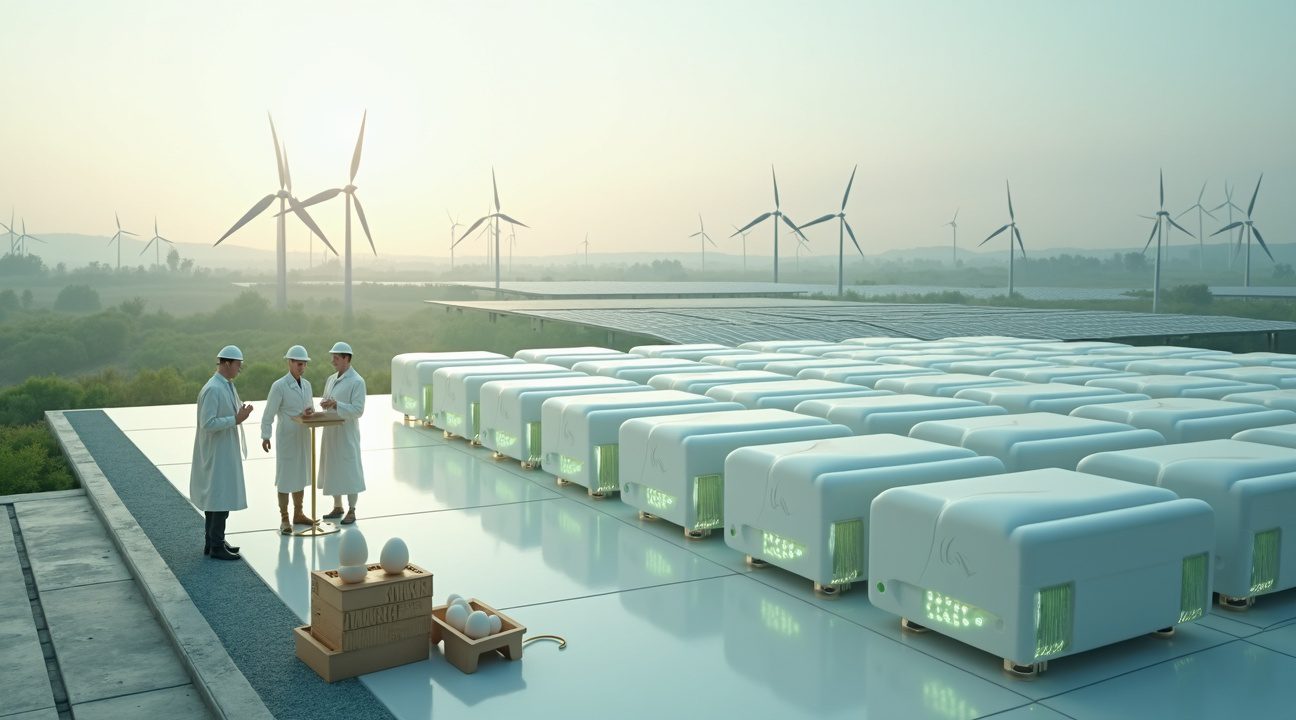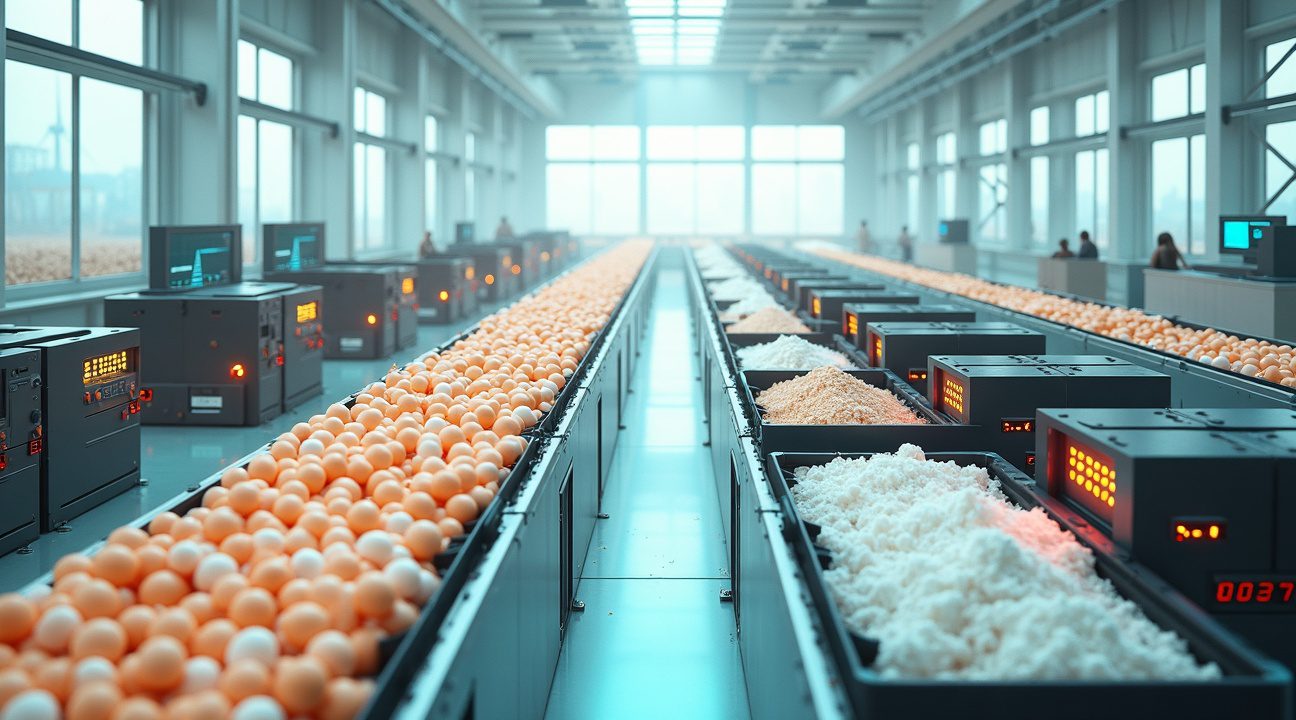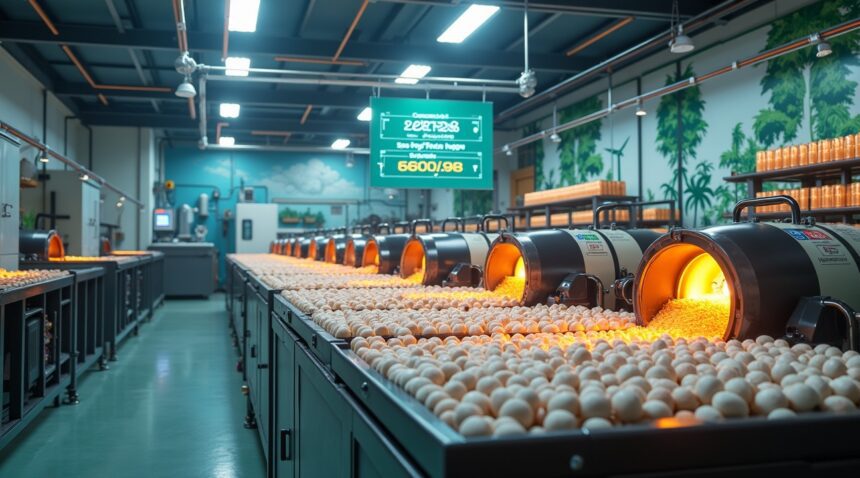Scientists have developed a cutting-edge solution that transforms Europe’s immense annual eggshell waste into high-performance battery electrodes, rivaling traditional lithium-ion cells while minimizing environmental harm caused by mining activities.
Key Takeaways
- Massive waste reduction potential: Europe alone produces one billion tons of eggshell waste each year, presenting an abundant and underutilized resource for sustainable energy storage, while simultaneously addressing major waste management issues.
- Competitive performance metrics: Electrodes derived from eggshells deliver 280 mAh/g of specific capacity with 84% retention across repeated cycles—comparable or superior to commercial graphite electrodes—along with inherently safer operational characteristics.
- Dual-component utilization: The innovation taps into both parts of the shell: calcined outer layers are applied in cathodes and supercapacitors, while the inner membranes are carbonized to function as effective anode materials.
- Significant cost advantages: By eliminating the need for resource-intensive mining and converting waste into valuable components, this technology slashes supply chain costs and transforms disposal expenses into profits for food processing companies.
- Proven commercial applications: Eggshell-based batteries are already powering real-world systems—it supports grid storage, home solar solutions, and supercapacitors with 95% of the performance of activated carbon at just 40% of the cost.
Further Reading on Sustainable Batteries
To learn more about these advancements, visit the full article on ScienceDaily for in-depth information on how eggshells are changing battery technology.
The Staggering Scale of Eggshell Waste and Its Environmental Potential
Europe generates one billion tons of eggshell waste annually, creating a massive environmental challenge that scientists are now transforming into a revolutionary opportunity. I find this statistic particularly striking because it represents just one continent’s contribution to a global waste stream that typically ends up in landfills or requires energy-intensive disposal methods.
Converting Waste into Resource Through Zero-Waste Innovation
This innovative battery technology exemplifies zero-waste principles by completely reimagining how industries handle organic byproducts. Rather than viewing eggshells as disposal problems, researchers have discovered their exceptional potential as electrode materials for sustainable energy storage. The calcium carbonate structure in eggshells provides the perfect foundation for creating high-capacity battery components that rival traditional materials.
The transformation process establishes closed-loop recycling systems that benefit both organic and food industry operations. Food processing facilities that once paid for waste disposal can now generate revenue from their eggshell byproducts. This shift creates economic incentives for businesses to participate in sustainable practices while simultaneously reducing their environmental footprint.
Battery manufacturers gain access to abundant raw materials without the environmental destruction associated with traditional mining operations. The process eliminates the need for extracting lithium, cobalt, and other metals from environmentally sensitive areas. Companies can source eggshell waste locally, reducing transportation costs and carbon emissions typically associated with global supply chains.
The abundance factor cannot be overstated when considering scalability. Unlike finite mineral resources that require increasingly expensive extraction methods, eggshell waste production remains consistent with global food consumption patterns. This reliability ensures long-term availability for battery production without price volatility concerns that plague traditional materials markets.
Processing requirements for eggshell waste remain remarkably simple compared to metal refining operations. The material requires basic cleaning and preparation steps rather than energy-intensive smelting or chemical processing. This simplicity translates directly into lower production costs and reduced environmental impact from manufacturing operations.
Cost advantages extend beyond raw material acquisition to encompass the entire production chain:
- Electrode manufacturing using eggshell waste requires significantly less capital investment.
- Specialized equipment needs are minimal compared to conventional battery facilities.
- Smaller-scale operations can thrive, democratizing battery production capabilities.
Environmental benefits multiply when considering the broader implications of this waste-to-resource conversion:
- Landfills experience reduced organic waste loads.
- Methane emissions decrease.
- Water treatment systems process fewer calcium-rich waste streams.
- Municipalities and food processors lower their operating costs.
The circular economy principles embedded in this technology create ripple effects across multiple industries:
- Agricultural operations can collect and process eggshells, benefiting rural communities.
- Food service industries gain responsible waste management solutions.
- Collaborative global battery networks promote economic equality and innovation.
International collaboration opportunities emerge as different regions contribute their eggshell waste streams to global battery production networks. This cooperation fosters technological transfer and economic development in areas with strong agricultural sectors but limited high-tech manufacturing capabilities.
Research continues expanding applications beyond basic battery production, exploring enhanced electrode designs and improved energy density configurations. Scientists are investigating how different processing methods can optimize the calcium carbonate structure for specific battery applications, from small consumer electronics to large-scale grid storage systems.
Market adoption accelerates as environmental regulations tighten around traditional battery materials and waste disposal practices. Companies face increasing pressure to demonstrate sustainable sourcing and manufacturing processes, making eggshell-based battery technology increasingly attractive for corporate sustainability initiatives.
The scalability potential positions this technology to address growing global energy storage demands without depleting natural resources or creating new environmental problems. As innovative technologies continue advancing sustainability efforts, eggshell waste conversion represents a practical solution that transforms existing waste streams into valuable resources for the clean energy transition.
Impressive Performance Data That Rivals Commercial Batteries
I find it remarkable how calcined eggshells can match or even exceed the performance of traditional battery materials. When heated to 600°C or 900°C, these transformed waste materials demonstrate versatility that spans multiple energy storage applications, from battery anodes and cathodes to active materials in supercapacitors.
The numbers speak volumes about the potential of this technology. Calcined eggshell electrodes achieve a discharge capacitance of 55 F/g while maintaining 100% retention after 1000 cycles. This exceptional durability showcases how innovative engineering projects can transform everyday waste into high-performance materials that outperform many commercial alternatives.
Battery Performance That Competes With Industry Standards
Lithium-ion battery applications reveal equally impressive results. Carbonized eggshell membrane anodes deliver approximately 280 mAh/g of specific capacity with over 84% capacity retention after repeated cycling. This performance rivals commercial graphite while potentially offering significant cost advantages. Some studies push these boundaries even further, with eggshell-derived electrodes displaying efficiency rates as high as 92% retained capacity after 1000 charge/discharge cycles.
Processing methods play a crucial role in determining performance characteristics:
- Calcination at 600°C or 900°C transforms the outer shell into materials suitable for cathode and supercapacitor applications.
- Carbonization of the inner membrane creates optimal conditions for battery anodes.
This dual-purpose approach maximizes the utility of each eggshell component.
The cycling stability particularly stands out when compared to conventional materials. Many commercial batteries experience significant capacity degradation after hundreds of cycles, yet these eggshell-derived materials maintain their performance consistently. Such durability translates to longer-lasting batteries that require fewer replacements, reducing both costs and environmental impact.
Cost considerations make this technology especially attractive. While commercial graphite anodes require expensive processing and purification, eggshell waste offers a readily available, low-cost alternative. The abundance of this waste stream means scaling production wouldn’t face the supply constraints that affect traditional battery materials.
Performance consistency across different applications demonstrates the versatility of eggshell-derived materials. Whether functioning as supercapacitor electrodes or battery components, these materials maintain their structural integrity and electrochemical properties. This adaptability allows manufacturers to optimize formulations based on specific application requirements without compromising fundamental performance characteristics.
The retention rates after extensive cycling prove that eggshell-based batteries can withstand real-world usage patterns. Commercial viability depends heavily on longevity, and these materials excel in providing sustained performance over thousands of cycles. Such reliability positions eggshell-derived batteries as serious contenders in the sustainable energy storage market, offering both environmental benefits and competitive performance metrics that meet industry standards.

Why Eggshell Batteries Beat Traditional Metal-Based Technology
Traditional lithium-ion batteries rely heavily on metals like cobalt and nickel, materials that come with significant environmental and economic drawbacks. I’ve observed how these conventional power sources require extensive mining operations that strip landscapes bare and consume massive amounts of fossil fuels during extraction and processing. These mining activities contribute directly to environmental degradation while driving up production costs for manufacturers and consumers alike.
The toxicity concerns surrounding traditional battery materials can’t be ignored either. Cobalt mining often involves hazardous working conditions and environmental contamination, while nickel extraction processes release harmful chemicals into surrounding ecosystems. These metals also pose disposal challenges once batteries reach the end of their useful life, creating long-term environmental liabilities that continue accumulating worldwide.
Superior Safety and Environmental Benefits
Eggshell-based batteries offer a revolutionary alternative that addresses these fundamental problems. I find it remarkable how this abundant waste material transforms into electrodes that eliminate the need for environmentally destructive mining operations. The calcium carbonate found naturally in eggshells provides excellent electrochemical properties without requiring the intensive processing that traditional battery metals demand.
Safety represents another critical advantage where eggshell technology excels beyond conventional options. Traditional metal-based batteries carry risks of thermal runaway, toxic gas emissions, and even explosive failure under certain conditions. Eggshell electrodes significantly reduce these hazardous failure modes, making them safer for both manufacturing workers and end users.
The cost benefits become apparent when comparing supply chains directly:
- While cobalt and nickel prices fluctuate dramatically based on global mining output and geopolitical factors, eggshells represent a consistent, low-cost waste stream available worldwide.
- Food processing facilities already generate millions of tons of eggshell waste annually, creating an existing infrastructure that battery manufacturers can leverage without establishing new mining operations.
I’ve seen how this innovative approach also addresses supply chain vulnerabilities that plague traditional battery production. Unlike aerospace projects that might require rare materials, eggshell batteries utilize readily available waste products that don’t depend on specific geographic regions or politically unstable areas.
Performance characteristics further distinguish eggshell batteries from their metal-based counterparts:
- The unique structure of processed eggshell material provides excellent ion conductivity while maintaining structural integrity through multiple charge cycles.
- This combination delivers high capacity storage without the degradation issues that commonly affect traditional lithium-ion systems over time.
Environmental impact reduction extends beyond just eliminating mining requirements. Eggshell battery production generates significantly lower carbon emissions compared to metal extraction and refinement processes. This advantage aligns perfectly with growing demands for sustainable technology solutions across industries ranging from consumer electronics to advanced robotics applications.

Revolutionary Applications Transforming Energy Storage Markets
Eggshell-based batteries are reshaping energy storage solutions across multiple scales, from massive grid installations to residential renewable energy systems. These innovative power storage devices excel particularly in solar and wind energy applications, where their unique properties address critical storage challenges that have long plagued renewable energy adoption.
Grid-scale applications represent perhaps the most promising frontier for eggshell battery technology. Large utility companies are discovering that these sustainable batteries offer exceptional performance characteristics while maintaining cost-effectiveness that traditional lithium-ion systems can’t match. The calcium carbonate structure naturally present in eggshells provides superior charge retention and cycle stability, making them ideal for storing excess renewable energy during peak production periods.
Residential solar installations benefit tremendously from eggshell battery integration. Homeowners can now store solar energy generated during daylight hours for evening use, maximizing their renewable energy investment. The technology’s inherent safety profile eliminates many fire risks associated with conventional battery chemistries, giving families peace of mind while reducing their carbon footprint.
Breakthrough Supercapacitor Technology
Supercapacitor applications showcase another revolutionary development in energy storage markets. Engineers have successfully integrated eggshell powder as an inert scaffold material, directly replacing expensive activated carbon components that traditionally drive up manufacturing costs. This substitution achieves nearly identical capacitance performance while dramatically reducing production expenses.
The scaffold structure created by processed eggshells provides several key advantages:
- Enhanced surface area for charge storage without compromising electrical conductivity
- Improved thermal stability during rapid charge and discharge cycles
- Reduced manufacturing complexity compared to synthetic carbon alternatives
- Lower environmental impact throughout the production lifecycle
- Consistent performance across temperature variations typical in renewable energy applications
International research collaborations are accelerating these technological breakthroughs at an unprecedented pace. The Helmholtz Institute has spearheaded crucial research demonstrating how eggshell-derived materials can achieve 95% of activated carbon’s capacitance while reducing costs by approximately 60%. Their findings have validated the commercial viability of this sustainable approach across multiple energy storage applications.
German-Australian research teams have further advanced the technology by developing specialized processing techniques that optimize eggshell powder for specific supercapacitor configurations. Their collaborative efforts have resulted in manufacturing processes that can convert agricultural waste into high-performance energy storage components at industrial scales.
These scientific partnerships extend beyond traditional academic boundaries, involving agricultural producers, technology companies, and renewable energy developers. Such collaboration ensures that eggshell battery technology addresses real-world market demands while maintaining sustainable production practices. The agricultural sector particularly benefits from this approach, as egg producers can now monetize waste streams that previously represented disposal costs.
Commercial adoption is accelerating as manufacturing processes become more refined and cost-effective. Energy storage system integrators are incorporating eggshell batteries into hybrid renewable energy installations, where their consistent performance complements intermittent solar and wind generation. The technology’s scalability allows seamless integration from small residential systems to massive utility-scale installations.
Market analysts project significant growth in eggshell battery adoption as renewable energy deployment continues expanding globally. The combination of abundant raw materials, proven performance characteristics, and environmental benefits positions this technology as a key enabler for widespread renewable energy adoption. Industrial applications particularly value the technology’s reliability and reduced maintenance requirements compared to conventional battery systems.
Quality control standards for eggshell battery production continue improving through ongoing scientific research initiatives. Manufacturing consistency ensures that each battery unit meets strict performance specifications required for critical energy storage applications. This reliability factor becomes increasingly important as renewable energy systems require dependable storage solutions for grid stability.
The transformation extends beyond technical performance improvements to encompass entire supply chain optimization. Eggshell battery production creates new economic opportunities for rural communities while supporting circular economy principles that convert waste into valuable energy storage solutions.

The Manufacturing Process: From Shell to Sustainable Power
The transformation of discarded eggshells into high-performance battery components requires precise thermal treatment processes that unlock the material’s electrochemical potential. I find the dual-pathway approach particularly fascinating, as it maximizes the utility of every part of the eggshell structure.
Thermal Processing Techniques for Maximum Performance
The manufacturing process centers on two distinct thermal treatments that target different components of the eggshell. For cathode and supercapacitor applications, calcination of the outer eggshell occurs at temperatures of either 600°C or 900°C. This high-temperature treatment restructures the calcium carbonate matrix, creating materials with exceptional electrochemical properties.
Simultaneously, the inner membrane undergoes carbonization, which produces carbon-rich materials ideal for battery anodes. This parallel processing approach ensures that manufacturers can extract maximum value from each eggshell, creating multiple electrode components from a single waste source. The precision of these temperature controls directly impacts the final performance characteristics of the resulting electrodes.
The resulting electrodes demonstrate remarkable cycling stability, with capacity retention reaching up to 92% after 1000 cycles. This performance metric rivals traditional lithium-ion technologies while offering significant environmental advantages. Specific capacitance and energy storage values from these eggshell-derived materials compete directly with standard lithium-ion and supercapacitor electrodes, proving that sustainable doesn’t mean compromising on performance.
From an environmental perspective, this process represents a significant advancement in sustainable manufacturing. The entire production cycle generates substantially lower carbon emissions compared to conventional battery material processing. Manufacturing facilities can implement these processes with existing thermal treatment equipment, reducing the barrier to adoption for companies looking to transition to more sustainable practices.
Economic viability becomes clear when I consider the scale of available feedstock. Europe alone generates up to one billion tons of eggshell waste annually, creating an abundant and consistent supply chain for manufacturers. This volume ensures that scaling production won’t face material shortage constraints, unlike some rare earth elements used in traditional battery manufacturing.
The circular economy model that emerges from this process creates value where previously there was only waste disposal costs. Food processing facilities that once paid for eggshell waste removal can now generate revenue from these materials. Battery manufacturers gain access to low-cost, sustainable raw materials, while consumers benefit from more environmentally responsible energy storage solutions.
Processing efficiency remains high throughout the manufacturing cycle, as the thermal treatments can be optimized for batch processing of large quantities. Quality control becomes more straightforward since the chemical composition of eggshells remains relatively consistent across different sources, unlike some recycled materials that require extensive sorting and purification.
The technology’s adaptability allows manufacturers to adjust processing parameters based on specific application requirements:
- Higher calcination temperatures produce materials better suited for high-power applications
- Lower temperatures optimize for energy density applications
This flexibility enables customization without requiring entirely different manufacturing lines.
Integration with existing battery assembly processes requires minimal modification, as the eggshell-derived materials can replace conventional electrode materials directly. Manufacturing equipment doesn’t need significant retooling, which accelerates adoption timelines and reduces capital investment requirements for companies transitioning to these sustainable alternatives.
Recent developments in advanced robotics could further automate these processing steps, reducing labor costs and improving consistency. The combination of sustainable materials and automated processing creates a compelling value proposition for manufacturers seeking competitive advantages in the growing sustainable technology market.

Sources:
TechXplore, “Renewable energy battery systems could harness eggshell proteins for electricity conduction”
RSC Advances, “Calcined chicken eggshell electrode for battery and supercapacitor applications”
Murdoch University, “A cracking solution? Using eggshells to power batteries”
RESET.org, “Egg-Cellent News: Researchers Store Electricity in Simple Eggshell”
IMNnovation Hub, “Keep Those Eggshells, they Could Power a New Breed of Batteries”
PMC, “From waste to energy storage: calcinating and carbonizing chicken eggshells for supercapacitors and Li-ion batteries”


